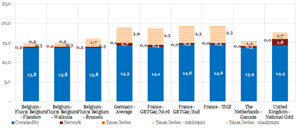Energy Prices: Conclusion
May 16, 2019
Add Comment
Electricity
Several key conclusions can be drawn regarding electricity prices:
1. Government Interventions
- Governments in all reviewed countries (Belgium, UK, Germany, France, Netherlands) intervene to reduce electricity costs for large industrial consumers.
- These interventions mainly target transport costs (e.g., Germany, Netherlands) and taxes/levies/certificate schemes (Belgium, UK, Germany, France, Netherlands).
- In France, the ARENH mechanism (regulated access to nuclear electricity) has become less relevant due to low market prices.
2. Commodity Costs Matter
- Germany, France, and the Netherlands benefit from lower wholesale electricity prices, giving them a competitive edge over Belgium.
3. Competitiveness by Consumer Profile
- For most industrial consumers (except in the UK), electricity prices are lower outside Belgium.
- Electro-intensive industries (high electricity users) in Germany and France enjoy significantly lower prices (15–40% cheaper than Belgium).
- Belgium’s E4 (very large baseload consumers) are more competitive than smaller consumers (E1–E3).
4. UK: The Outlier
- The UK has the highest electricity prices due to:
- Higher commodity costs.
- Elevated network and tax/levy charges.
Natural Gas
Key findings for gas prices:
1. Commodity Costs Dominate
- Gas prices are heavily influenced by commodity costs, more so than electricity.
2. Price Convergence
- Gas prices are similar across Belgium, UK, Northern France, Germany, and the Netherlands (except Southern France).
- In January 2016, Belgium had slightly lower commodity costs than its neighbors.
3. Competitiveness by Region
- Flanders and Wallonia offer the most competitive gas prices for industrial users (excluding feedstock consumers).
- For feedstock consumers (using gas as raw material), the Netherlands is slightly cheaper.
- Belgium’s advantage comes from low network costs and taxes.
4. Competitiveness Scorecard
To summarize Belgium’s energy cost competitiveness:
Electricity:
- UK is less competitive than Belgium.
- Netherlands is consistently cheaper for all profiles.
- Germany & France are cheaper only for electro-intensive industries.
- Wallonia vs. Flanders:
- Wallonia is 10% more expensive for E1 & E2 (due to regional taxes).
- Differences shrink for E3 & E4 (~2%).
Gas:
- Belgium (Flanders/Wallonia) is the most competitive for non-feedstock consumers.
- For feedstock consumers, the Netherlands is slightly cheaper.
Final Considerations
- Electro-intensive industries in neighboring countries benefit from bigger discounts (unlike Belgium, where discounts depend mainly on consumption).
- The scorecard simplifies a complex reality—some industries in Germany/France pay much less due to electro-intensity exemptions.
Sources:

0 Response to "Energy Prices: Conclusion"
Post a Comment